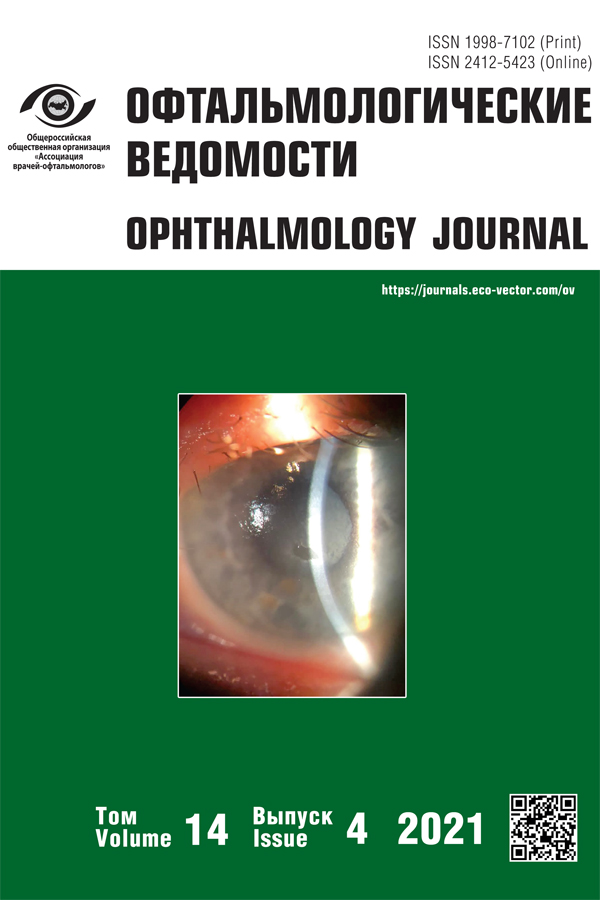Why are patients with mature cataract admitted to hospital? Challenges for cataract surgery
- 作者: Ivachev E.A.1,2, Denisova I.P.1, Anisimova E.V.1, Tanash M.A.3
-
隶属关系:
- The departmental clinical hospital at the station Penza of JSC “Russian Railways”
- Penza State University
- Peoples’ Friendship University of Russia (RUDN University)
- 期: 卷 14, 编号 4 (2021)
- 页面: 83-90
- 栏目: In ophthalmology practitioners
- ##submission.dateSubmitted##: 28.10.2021
- ##submission.dateAccepted##: 15.02.2022
- ##submission.datePublished##: 15.12.2021
- URL: https://journals.eco-vector.com/ov/article/view/84019
- DOI: https://doi.org/10.17816/OV84019
- ID: 84019
如何引用文章
详细
BACKGROUND: A lot of patients are admitted to hospital with mature cataract, this raises the risk of complications and makes longer the rehabilitation period.
AIM: To identify the reasons for admission of patients with advanced forms of cataract, and associated factors complicating the surgery in these patients.
MATERIALS AND METHODS: 674 operated patients with various degrees of lens opacity; out of them, 145 (21.5%) cases were with mature cataracts.
RESULTS: 95.2% (n = 138) of patients did not seek ophthalmological attention, 4.8% (n = 7) of patients noted that they were referred late due to the fault of their local ophthalmologists. In 31.9% of cases (138 patients), the main cause was “absence of an ophthalmologist in the outpatient polyclinic”. The patient’s lack of funds for the purchase of an intraocular lens (IOL) was the reason in 26.1%. In 15.2% of cases, patients refused surgery due to domestic problems. 14.5% of patients lived with the idea of self-restoration of vision. Low transportable patients amounted to 5.1%; in 4.3% of cases, elderly patients did not perceive the loss of spatial vision in one eye. Remaining 2.9% of patients from the psychoneurological dispensary were admitted for phacoemulsification having intumescent cataracts. The maturity of the cataract leads to certain intraoperative difficulties, which are accompanied by additional manipulations, increasing the risk of complications and the duration of procedures. These include: pupil diameter less than 5 mm – 37.2%; pseudoexfoliation syndrome – 22.8%; the presence of an advanced intumescent cataract in 36.6%; shallow anterior chamber – 44.8%; lens subluxation – 24.1%; atrophy of the pupillary margin – 39.3%; fibrosis of the posterior capsule diagnosed intraoperatively – 13.8%. Phacoemulsification was carried out using the Optimed phaco machine (Russia). For an immature cataract, we used a power of 30% and the time spent was 2.73 seconds; with a mature one – 60% and 9.96 seconds respectively. The best corrected visual acuity on Day 1 after cataract extraction was 0.53 ± 0.27, on Day 7 – 0.73 ± 0.22, after 3 months – 0.76 ± 0.25.
CONCLUSIONS: Mature cataract is encountered in 21.5% of all cataract surgeries. In 95.2% of cases, patients themselves did not seek medical help. The maturity of the cataract led to certain factors complicating the course of surgery: pupil diameter less than 5 mm, swelling of the lens cortical masses, shallow anterior chamber, lens subluxation, atrophy of the pigment border of the iris. The ultrasound power used in the mature cataract surgery was 2 times higher than in that of immature ones; and the operating time of ultrasound increased by 3.6 times.
全文:
作者简介
Evgenii Ivachev
The departmental clinical hospital at the station Penza of JSC “Russian Railways”; Penza State University
编辑信件的主要联系方式.
Email: eivachov1@yandex.ru
ORCID iD: 0000-0001-5662-4195
SPIN 代码: 7766-1251
Cand. Sci. (Med.), MD, Ophthalmologist, Head of Ophthalmology Department, Assistant of Department
俄罗斯联邦, 17, Chekhova st., Penza, 440000; PenzaIrina Denisova
The departmental clinical hospital at the station Penza of JSC “Russian Railways”
Email: ipdenisova@gmail.com
ORCID iD: 0000-0002-9911-0255
Ophthalmologist
俄罗斯联邦, PenzaElena Anisimova
The departmental clinical hospital at the station Penza of JSC “Russian Railways”
Email: makarova.elena1985@gmail.com
ORCID iD: 0000-0002-5819-6494
Ophthalmologist
俄罗斯联邦, PenzaMohammed Tanash
Peoples’ Friendship University of Russia (RUDN University)
Email: dr.mohammedtanash@gmail.com
ORCID iD: 0000-0002-3540-0683
SPIN 代码: 3072-5574
Cand. Sci. (Med.), MD, Ophthalmologist
俄罗斯联邦, Moscow参考
- Branchevsky SL, Malyugin BE. Incidence of visual impairment due to cataract according to the RAAB study in Samara. Fyodorov Journal of Ophthalmic Surgery. 2013;(3):82–85. (In Russ.)
- Evseeva AA, Antropov AYu. Gender differences of comorbid nervous and mental pathologies in patients with cataract. University proceedings. Volga Region. Medical sciences. 2015;36(4):31–39. (In Russ.)
- Tomilova EV, Zagorulko AM, Shiryaev IV. Topical mydriatics in small-incision cataract extraction. Fyodorov Journal of Ophthalmic Surgery. 2014;(2):10–14. (In Russ.)
- Orlova OM, Trubilin VN, Zhudenkov KV. Analysis of cataract progression in Russia based on the natural mortality data. Practical medicine. 2016;(2):70–73. (In Russ.)
- Ioshin IE, Tolchinskaya AI. Surgical treatment of patients with bilateral cataracts. Fyodorov Journal of Ophthalmic Surgery. 2013;(2):10–15. (In Russ.)
- Braziticos PD, Tsinopoulos IT, Papadopoulos NT, et al. Ultrasonographic classification and phacoemulsification of white senile cataracts. Ophthalmology. 1999;106(11):2178–2183. doi: 10.1016/S0161-6420(99)90502-X
- Pirogova ES, Fabrikantov OL, Nikolashin SI. Types of lens structure in intumescent cataract. Ophthalmology in Russia. 2018;15(2S): 153–159. (In Russ.) doi: 10.18008/1816-5095-2018-2S-153-159
- Fabrikantov OL, Nikolashin SI, Pirogova ES. Diagnostic value of modern methods of ocular anterior segment visualization in intumescent cataract. Ophthalmology in Russia. 2019;16(3):350–354. (In Russ.) doi: 10.18008/1816-5095-2019-3-350-354
- Yousef YoN, Yousef SN, Vvedenskiy AS, et al. Femtosecond laser-assisted facoemulsification of hypermature cataract. Ophthalmology in Russia. 2020;17(3S):592–596. (In Russ.) doi: 10.18008/1816-5095-2020-3S-592-596
- Ioshin IE, Khachatryan GT, Ozderbayeva AA. Analysis of Ozil IP technology results in phacoemulsification of high density cataract. Fyodorov Journal of Ophthalmic Surgery. 2011;(2):59–63. (In Russ.)
- Loskutov IA, Korneeva AV, Lebedev PA. The use of new cohesive ophthalmic viscoelastic in cataract surgery. Ophthalmology Journal. 2019;12(4):51–56. (In Russ.) DOI: l0.17816/OV17539
- Burhard D, Schultz T. Laser assisted cataract surgery in small pupils using mechanical dilatation devices. J Refract Surg. 2013;29(12):858–862. doi: 10.3928/1081597X-20131115-06
- Fabrikantov OL, Pirogova ES, Nikolashin SI. Technique for optimizing morganian cataract phacoemulsification. Ophthalmology in Russia. 2018;15(2S):160–165. (In Russ.) doi: 10.18008/1816-5095-2018-2S-160-165
- Shukhaev SV. Kombinirovannyi ul’trazvuk v khirurgicheskom lechenii plotnykh katarakt [dissertation]. Moscow, 2019. Available from: https://www.mntk.ru/files/upload/Dissertacia_Shukhaev.pdf. (In Russ.)
补充文件
















